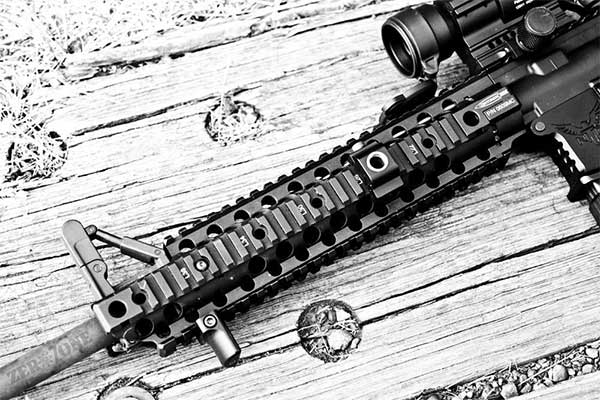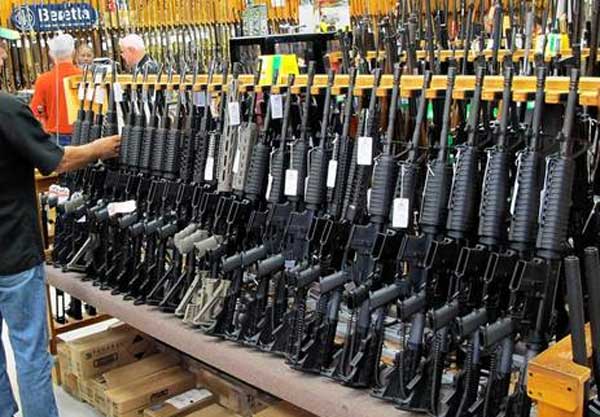By Charles C.W. Cooke
This feature appears in the August ’16 issue of NRA America’s 1st Freedom, one of the official journals of the National Rifle Association.


Washington, DC – -(Ammoland.com)- In the middle of June, a self-described radical Islamist ruthlessly gunned down a room full of Americans in the worst terrorist attack on United States soil since 9/11. In response, the Obama administration joined the usual suspects within the media and inveighed relentlessly against the perpetrator of the crime. It was time, the president said, to get serious in fighting terrorism, and that meant “making it harder for people who want to kill Americans to get their hands on assault weapons.” Once again, the AR-15 was under the microscope.
If it seemed a touch peculiar that the president would reserve his most vehement words of condemnation for a firearm, rest assured that it was. But, alas, it was also par for the course. In the eyes of America’s ever-zealous gun-controllers, the AR-15 represents all that is wrong with the right of the people to keep and bear arms, and, indeed, with the country’s culture at large.
In consequence, banning it is imperative not only in the fight against “gun violence,” but as a means by which individualism itself can be checked. Time and time again, those who own AR-15s—or similar—are cast as reactionaries, or bitter clingers, or, worst of all, as full-on terrorists.
“Why,” the critics invariably inquire, “are we allowing this supergun and its unbalanced owners to destroy the public peace?”
In pushing back against this rather ignorant way of thinking, I could marshal an almost endless supply of inconvenient facts. I could point out, for example, that despite all of the propaganda to the contrary, the AR-15 is not a “supergun,” a “machine gun,” an “automatic weapon” or an “assault rifle”; that it does not “spray bullets” indiscriminately, as one sees in the movies; that it is owned by a fascinating cross-section of American citizens; that it is not especially powerful, especially when compared to rifles that are primarily used for hunting; and that it is used so infrequently in crimes that the FBI doesn’t even bother to keep statistics.

Moreover, I could explain that there are a host of reasons why the AR-15 is the most popular rifle in the country. Among them, that its ergonomic design makes it universally easy to use; that its modular structure renders it simple to repair or to customize; and that its pinpoint accuracy makes it the ideal choice for those who are weaker or lacking in training. But I won’t. For now, at least, I shall leave those arguments to those who are more technically qualified than am I, and focus instead on the principle that is at stake in the debate over the AR-15.
That principle? That Americans are in charge of their representatives, and not the other way around.
In most countries, the regnant political presumption is that the government enjoys unchecked power unless otherwise stated. In America, mercifully, the opposite doctrine applies. To review the debates that raged both before and after the revolution of 1776 is to learn not only that our forebears thought of government as a means primarily of protecting liberty, but that they did not believe they were obliged to surrender their pre-existing rights when they entered into the compact. It is for this reason that the federal government was given only certain, carefully delineated powers.
It is for this reason that the framers of the Constitution were so keen to impose hard checks on authority. And it is for this reason that, even today, civil society takes on a much greater role in the United States than it does elsewhere.

All told, there are few better illustrations of this than the Second Amendment—the meaning of which is not at all confusing if one understands the era in which it was written. As the English system of juries was born from a sensible unwillingness to hand full judicial control over to a clique of professional judges, so the right to bear arms came from a general reluctance to put unalloyed trust in the power of the state.
Grudgingly, Americans consented to be guarded by a standing army. But, as a check upon the ambitions of their government and its staff, there would be the militia, which, per George Mason, would be composed of “the whole people, except for a few public officials.”
This arrangement was intended to achieve two crucial ends. The first, Tench Coxe wrote in 1791, was to ensure that there would be a means by which the people could resist should “the military forces which must be occasionally raised” seek to “pervert their power.” The second, as John Locke had confirmed in his Two Treatises, was to affirm that self-defense was an unalienable individual right that “could not be denied the community,” and that to delegate it entirely to Leviathan was a foolish idea indeed. To the founding generation it did not matter whether the question at hand was the protection of the home or the best insurance against would-be tyrants, the answer was invariably the same. “Who will defend me if things go wrong?” came the inquiry. “You will,” came the answer.
This idea has been cherished throughout American history. In Europe, ostensibly free people are routinely denied the opportunity to take charge of their own defenses on the grounds that the police and the security services can do a better job. In America, by contrast, these organizations have been seen as an addition to—rather than a replacement of—the status quo. Notably, the U.S. Supreme Court has recently confirmed that the police have “no specific legal duty” to protect individuals from threats. Now, as in the 18th century, the prevailing assumption is clear: At all levels, Americans are responsible for their own security—and if the government can help, that’s a bonus.
All of which, ultimately, brings us back to the AR-15. In my view, there is nothing that better symbolizes the proper relationship between the citizen and the state than a robust right to keep and bear arms.
When one stops to think about it, it makes no logical or constitutional sense for the people’s employees (our politicians) to be permitted to disarm their employers (the voters).
And yet Americans fight constantly to prevent their representatives from doing just that. During heated debates, owners of common rifles such as the AR-15 are asked by those in positions of power, “Why do you need one of those?”—to which the appropriate response, in a voice dripping with suspicion, is first, “Why don’t you want me to have one?” And second, “If the IRS and the Department of Veterans Affairs need $20 million worth of firearms; and the Animal and Plant Health Inspection Service needs shotguns, propane cannons and drones; I think I’m on solid ground with my AR, thank you very much.”
Bluntly put, it is impossible to separate out the structure of the American settlement from the scope of the right to keep and bear arms.
If, as many desire, the federal government were to rid the people of the United States of their most commonly owned rifle, it would be ushering in not just a change in the legal status quo, but a profound shift in the balance of power. Crises, as Edmund Burke observed, are perilous for the free.

Those who wish to avoid such a change must thus ensure that their rifles are cast in the correct light. Day in and day out, the gun control movement attempts to represent the AR-15 as being in some way extravagant or outré—as the unlovely corruption of a worthwhile principle. “Sure,” one hears it said, “I believe in the Second Amendment, but that gun just takes it too far.”
This, of course, is nonsense. In truth, the AR-15 is the contemporary equivalent of the musket—an everyday gun for everyday citizens. Fundamentally, the AR-15 is democratic. It is the yeoman’s gun; the people’s gun; the Brown Bess
of our era. It is what William Blackstone was referring to when he praised private arms; what George Orwell had in mind when he sought to keep the “rifle on the wall of the labourer’s cottage;” what Ida B. Wells imagined when she recommended that endangered blacks give a rifle “a place of honor” in their homes. As the standard firearm of its day, the AR-15 does not represent some bizarre over-extension of the right to keep and bear arms. It is the very core of that right.
This being so, it is unsurprising that the AR-15 has played a valuable role in ensuring that the Second Amendment can be enjoyed by everybody. The old line that “God created men, Sam Colt made them equal” hit on a key truth: Namely, that the right to self-defense remains largely theoretical absent the widespread availability of easy-to-use methods to provide for that self-defense, like firearms. On paper, both a diminutive woman and a 230-pound criminal have precisely the same opportunities to defend themselves. But unless she can find a way of overcoming the natural disparities in strength, that fight will not be a fair one. The AR-15 provides that way.

Speak to any gun store owner and he will tell you that the AR-15 is so wildly popular in large part because it is so versatile. Thanks to its smart design, it can be handled without trouble by men and by women, by children and by the elderly, by the able-bodied and by those with disabilities. Moreover, it can be easily and inexpensively customized to fit any body shape or size, and because its parts are interchangeable, they can be found by the inexpert and fitted without the need for costly tools. Because the media is proudly ignorant on all matters related to the Second Amendment, many members of the general public have come to believe that the AR-15 is unusually “high powered” or that its shooting system functions differently than other commonly used firearms. That, though, is wholly false. The AR-15 is unusual only insofar as it is usefully protean. Want a gun, but have special needs? There’s an app for that.
Which is to say that our present political contretemps is the product less of the fallout from a specific event, and more of a deep-seated and longstanding philosophical disagreement as to how modern Americans should relate to their government and to each other. In our cynical, distracted age it can be tempting to perceive the icons of the past as untouchable heroes, or to regard their grand deeds as one might a tall tale in a fading book of fables. But to elevate those who have stepped into the breach is often to do ourselves a disservice—indeed, if indulged too readily, it is to separate us cleanly from our history.
The United States has always been home to people who filled those roles that the government could not, and who proudly took responsibility for themselves and their security. To deprive them of the most effective, most democratic, most popular tool with which they choose to play that role would be a dangerous departure indeed.
Charles C. W. Cooke is the editor of National Review Online.
About:
Established in 1975, the Institute for Legislative Action (ILA) is the “lobbying” arm of the National Rifle Association of America. ILA is responsible for preserving the right of all law-abiding individuals in the legislative, political, and legal arenas, to purchase, possess and use firearms for legitimate purposes as guaranteed by the Second Amendment to the U.S. Constitution. Visit: www.nra.org
